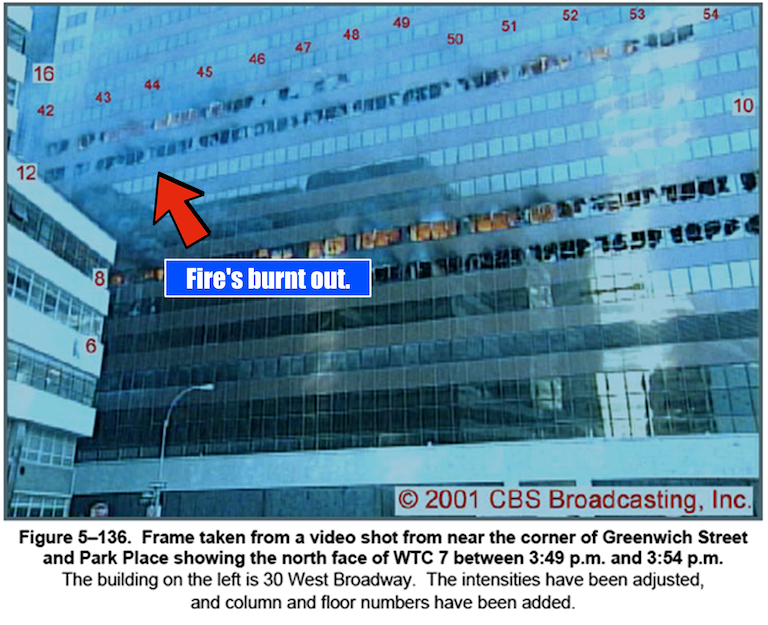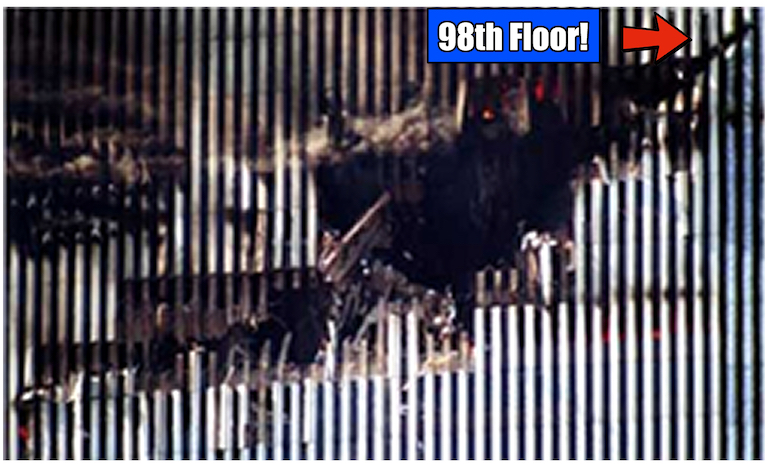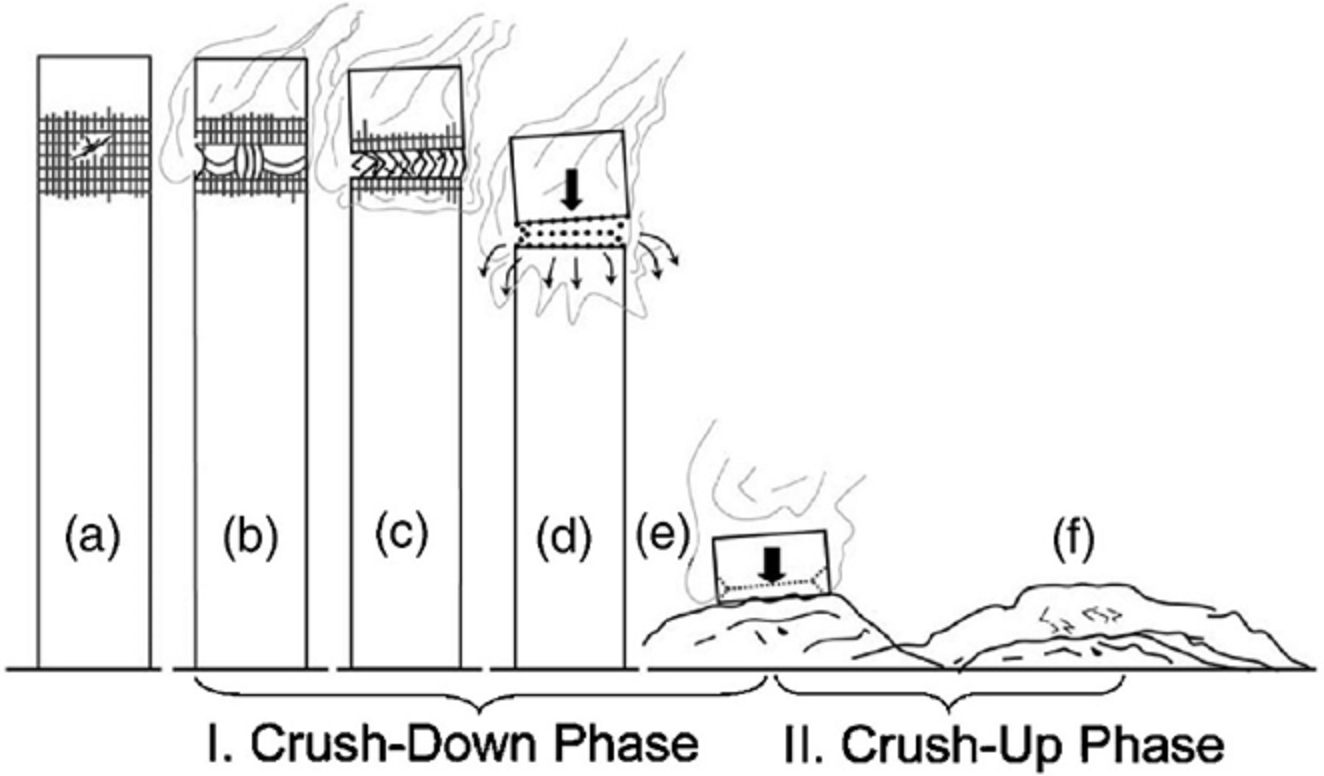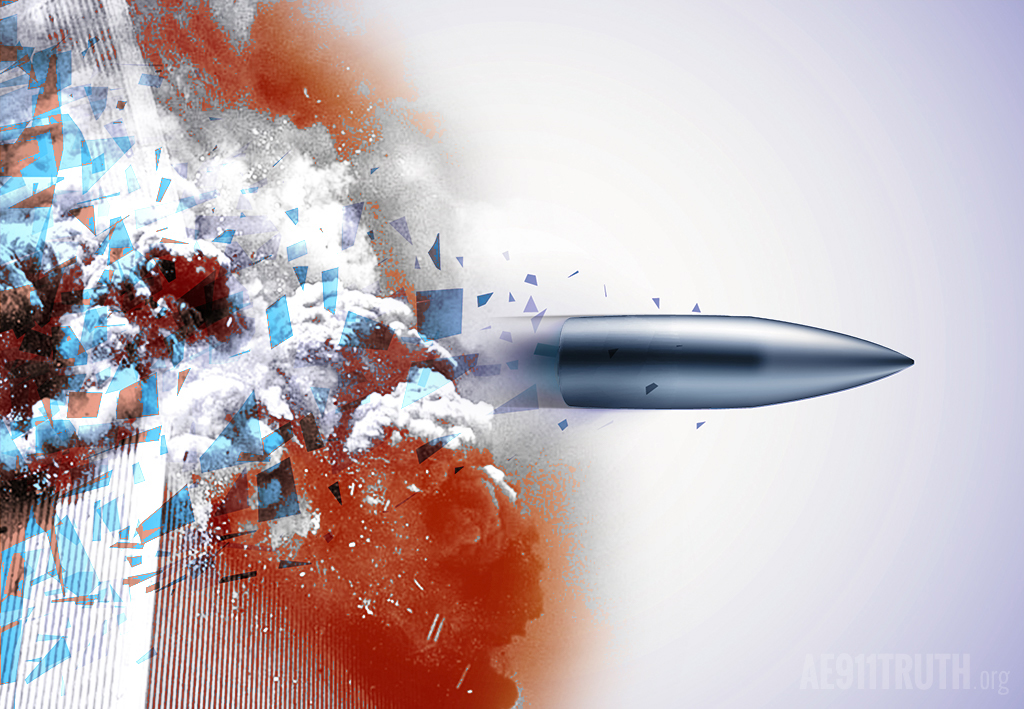In the mythology of movies and books, the best way to kill a werewolf is with a silver bullet.
In the real world, a silver bullet’s only power is in its metaphorical meaning as something that can bring an instant stop to something else.
For over two decades, the official explanation given by the National Institute of Standards and Technology (NIST) for the destruction of World Trade Center buildings 1, 2, and 7 has shaped the historical narrative of September 11th, held up by a government and a legacy media that simply want the controversy to die.
Yet this official explanation is so weak that there are “silver bullets” capable of bringing it to an instant stop — at least in an environment where logic and a dispassionate review of the facts overrule outraged passions and unwavering agendas.
While AE911Truth and others have built an entire body of evidence that has served to leave nothing of the NIST reports but a hollow skeleton, within that body of evidence there are key points, often overlooked, that by themselves undermine the very foundation on which the NIST reports stand.
These are points that, for those skeptical of the controlled demolition hypothesis, should at the very least justify a concession that the NIST reports are devastatingly flawed.
In this article we will examine a few of these “silver bullets” and explain why each of them conclusively refutes the story we’ve been told by our government. Though every piece of evidence we have gathered over the years is damning to the official reports, these key points swiftly and decisively demolish NIST’s account of the building failures at its foundation.
WTC 7:
“Hey, buddy, . . . where’s the fire?”
An expression typically said to someone who is in a hurry for no apparent reason, in the case of World Trade Center Building 7 the meaning of this section’s title is quite literal: Where is the fire?
To begin, let’s examine the basic premise of NIST’s theory as to how WTC 7 came down.
According to NIST, the initiating event of WTC 7’s destruction occurred when raging fires in the northeast corner of the 12th floor heated the floor beams on the 13th floor and caused them to thermally expand, pushing a critical girder between core column 79 and exterior column 44 (girder A2001) off its seat at column 79. This then triggered a series of local failures that ultimately caused the interior of the building to fall first, followed by the complete and perfect collapse of the building’s exterior in less than seven seconds.
Though such a phenomenon of heated and thermally expanding beams had never been responsible for bringing about the complete and utter demise of a large, steel-framed high-rise before, this was the story presented to the American people after seven years of alleged research.
When an unprecedented and as before unimaginable scenario is being presented as a conclusion, a preponderance of evidence should be expected. Along with that, there’s an unsaid expectation that all observable facts have been gathered and considered by the researchers. Certainly, while some small mistakes can be brushed aside and minor observations ignored, this isn’t the case when such observations undermine the entire premise of the conclusion.
One observation that undermines the entire premise of NIST’s conclusion is this: The fires in the area where NIST claims the collapse initiated were already out at least an hour before WTC 7 went down.

Note the horizontally numbered exterior columns (42 through 54) and the vertically numbered floors (6 through 16) in the video frame above. Like a graph in a school textbook, you can trace with two fingers where exterior column 44 and the 12th floor meet, indicating the area where this initiating event allegedly happened.
Rather than the orange, raging fires that appear towards the middle of the frame, we instead see the black void of shadow within the broken windows, indicating that fires were once there, causing the breakage of those windows, but were no longer present by 3:54 PM. This was more than an hour before WTC 7 came down at 5:20 PM.
The problem is that NIST’s collapse scenario didn’t take an hour and half from the time of the fires to materialize. Rather, it involves a rapid sequence of events, where the beams allegedly pushed the girder off its seat and led to the failure of the entire building in a matter of seconds. The fire would’ve needed to be present and strong when the floor beams allegedly pushed the girder off its seat, because once the fire left and the beams cooled down, they would have contracted and would not have pushed the girder off its seat.
Yet, as the video and photographic evidence demonstrate, the fires weren’t in that spot at all.
Desperate to maintain the credibility of NIST’s conclusions, defenders of the official narrative may be tempted to speculate that in the roughly 90 minutes between when this video was taken and when WTC 7 went down, the fires may have returned to the alleged area of collapse initiation.
This speculation, however, does not hold water for a couple reasons.
The first is that, just like everything else in nature, there are rules associated with how fires burn and spread from place to place. Fire consumes combustibles in an area unless a fire suppression system, such as sprinklers, intervenes. Fire expands and consumes nearby combustibles; that is how it spreads. Once all the combustibles in an area have been consumed, the fire burns out in that area. That’s the reason you need to throw fresh logs in your fireplace if you want to keep the fire inside it alive.
So, we know the combustibles within NIST’s supposed area of collapse initiation were already consumed by the time the above video was taken. Unless more combustibles were miraculously added to the area during the hour and a half between the time the video was filmed and the time of WTC 7’s destruction (more than unlikely in an evacuated office building), there was nothing left there to burn.
While those who resist the controlled demolition evidence have been known to stretch their imaginations to great lengths to justify dismissing that evidence, any scenarios they might invent to claim the fires returned to the alleged area of collapse initiation during that hour and a half are simply not credible.
Not to mention, NIST's own description of the observed fire spread corroborates that there were no fires in the northeast corner of the 12th floor after 4:00 PM:
“The next time an image showed fire on the 12th floor was just before 3:00 p.m., when flames were observed between windows 12-44C and 12-45C, east of center on the north face. The fire had apparently bypassed the northeast corner of the floor and spread internally to the north face. In less than 15 min, the fire on the north face spread rapidly to the east to fully engulf the northeast corner of the floor and more slowly to the west, reaching as far as Column 47. Over the following 40 min, the fire spread to the west in starts and stops, sometimes bypassing groups of windows before later opening them. By around 3:45 p.m., flames had appeared between Column 55 and 56, toward the west end of the north face. After this time, views of windows further to the west were limited. An image taken around 5:00 p.m. showed that the fire had continued spreading west, and intense flames were coming from windows on the north face at the northwest corner.” — NCSTAR 1-9, p. 245 [Emphasis added.]
After all but admitting there were no fires in the northeast corner of the 12th floor after 4:00 PM, NIST would then be forced to mislead in its “probable collapse sequence” — i.e., its stated theory of how the building collapsed — by implying that once the fires reached the northeast corner between 3:00 PM and 4:00 PM, they would stay there. Below are steps 2 and 3 of NIST’s probable collapse sequence:
“2. Growth and Spread of Fires. Fires on the lower floors (Floors 7 to 9 and 11 to 13) grew and spread since they were not extinguished either by the automatic sprinkler system or by FDNY because water was not available. By 3:00 p.m. to 4:00 p.m., these fires were generally concentrated on the east and north sides of the northeast region.
“3. Initial Local Failure for Collapse Initiation. Fire-induced thermal expansion of the floor system surrounding Column 79 led to collapse of Floor 13 that triggered a cascade of floor failures. This, in turn, led to loss of lateral support to Column 79 over nine stories, resulting in the buckling failure of Column 79.” — NCSTAR 1-9, p. 609
That’s all well and good for the east and north sides of the northeast region during the period between 3:00 PM and 4:00 PM, but what about at 5:20 PM? You know, the time the building actually fell?
All of this to reiterate that, from the video frame above and from NIST’s own observations of the fires, we know they had burned out in the area where the collapse purportedly started.
The fires didn’t come back to the area to finish the job, either. They had already moved on.
Without fire to initiate the collapse, there is no initiating event, rendering the rest of NIST’s collapse scenario nothing more than an elaborate series of non-existent events.
Just like the person in the fictional paradox who travels back in time to kill his grandfather before he himself is ever born, the documented facts in this matter cause NIST’s collapse sequence to simply fade away and cease to exist, leaving NIST with no theory and no final report in its hands whatsoever.
The North Tower:
Proofing NIST’s Fireproofing Scenario
According to NIST, after the airplanes struck the Twin Towers, the in-place fireproofing was blown off the trusses, leaving them exposed to the ensuing fires inside. Then, we are told, heat from the fires caused the trusses to sag, which had the effect of pulling the exterior columns inward to the point of buckling, causing the floors above the airplane impact zones to give way.
NIST then notoriously stops its analysis at collapse initiation and instead cites the theory advanced by Northwestern University engineering professor Zdeněk Bažant, who claims that, as those floors came down, they acted as a piledriver, crushing the floors below all the way to ground before also destroying themselves in the final “crush up” phase of their collapses. (Bažant needed an explanation for why there were no large top blocks sitting on the debris at Ground Zero, so he came up with the logic-defying crush-up phase.)
While this scenario has many problems, all of which have been well documented over the years by AE911Truth and others, let’s focus on the dislodged fireproofing, as it is a critical component in NIST’s story.
So critical, in fact, that NIST itself acknowledged the importance of the fireproofing being knocked off for its scenario to be plausible, as the fireproofing would have protected the trusses from the heat were it still in place:
“The towers likely would not have collapsed under the combined effects of aircraft impact and subsequent multi-floor fires encountered on September 11, 2001 if the insulation had not been widely dislodged or had been only minimally dislodged by the aircraft impact.” — NCSTAR 1-6, p. 283
As you can see, NIST put a lot of eggs in the dislodged fireproofing basket.
NIST also acknowledged in its report that the collapse of the North Tower initiated on the 98th floor. While to laymen this may seem like a dry detail, it’s quite critical, especially when we observe where the airplane impacted the building.

What should first jump out to the casual observer looking at the photo above is that the damage from the airplane impact occurred mostly from the 93rd to 97th floors, with only the tip of the airplane’s wing touching the 98th floor.
In fact, the damage to the 98th floor was so minor that NIST, while describing the damage to the other floors, didn’t bother to describe the damage to the 98th floor in its report.
As engineer Tony Szamboti wrote in his witness statement in support of the effort to obtain a new inquest into the death of UK citizen Geoff Campbell, who perished in WTC 1 on 9/11:
“The NIST report claimed that the south face of WTC1 bowed inward between the 95th and 100th floors and that the building at this point was ‘poised to collapse’. However, NIST offered no mechanism for how the inward bowing of that one face could cause the entire 98th floor to completely collapse in an even way. The lack of explanation from NIST, on such a crucial element of its hypothesis, fatally undermines that hypothesis.”
Remember, NIST’s entire scenario is dependent on the fireproofing being knocked from the trusses. Therefore, one would presume the fireproofing would need to have been knocked from the trusses on the floor where the collapse started.
Yet the fireproofing on the 98th floor couldn’t have been knocked off by the airplane impact. As has already been established, the impact hardly touched that floor. Given that fact, with the fireproofing still intact on the 98th floor, the trusses on it would not have sagged and thus the exterior would not have weakened.
Here, at the nucleus of NIST’s scenario, we’re presented with a glaring contradiction. It is one that defenders of the official story would likely wish to brush off, yet it simply can’t be ignored, as one critical piece of the report cancels out another.
At the very least, this contradiction shows an area of needed correction and a reason for NIST to revisit its findings.
On a broader level it shows, by NIST’s very own words, that its supposed initiating event for the collapse of the North Tower could not have happened.
Like bad code planted within the hard drive of the NIST report, this key point causes the agency’s entire story to shut down and cease to function.
Just as in the case of WTC 7, without an initiating event, NIST is left with no report and no explanation for why the North Tower came down, rendering moot NIST’s scant, unsupported claims about what happened after collapse initiation.
The Antenna Signals What Happened
To boil down NIST’s collapse scenario for the Twin Towers into even simpler terms, NIST would have us believe that the towers essentially followed these three steps to their demise:
- The trusses sagged and pulled the exterior columns inward.
- The exterior columns gave in to this sagging and buckled, followed by the buckling of the core columns, at which point the top blocks over the areas of airplane impact then began to fall straight down.
- These top blocks crushed the floors below all the way to the ground.
Considering that nobody could see what was happening inside the Twin Towers before they came down, the story is plausible enough for the TV viewers at home and for defenders of the official story to stand by.
That is until you watch the video of the North Tower collapsing.
The North Tower was distinctive because of the large antenna protruding from the top of it. Although, due to the shadows and heavy smoke, we couldn’t see inside the buildings through the holes created by the airplanes, at the time of the North Tower’s destruction, the antenna ironically signaled what was taking place within. In the video, we see that, rather than the outside walls of the North Tower pulling inward at the onset of collapse, instead the antenna dropped first.
Why is this significant?
Because it shows that the collapse initiated in the building’s core columns and was not caused by the trusses pulling the exterior columns inward. It demonstrates a different series of steps that obviously happened as the destruction of the North Tower took place.
- The core columns were severed, causing the antenna to drop first.
- The falling core of the building pulled the trusses inward and down.
- The trusses pulled on the exterior of the building, giving enough of a perception of the exterior initially giving out for NIST to seize on and claim as the beginning of the collapse.
- The rest of the building was destroyed in an explosive manner, ejecting steel and pulverized concrete hundreds of feet in all directions.
Regardless of what anyone wants to argue about the final stage in NIST’s list of events versus my list, the motion of the North Tower antenna clearly invalidates the first list of events and is more consistent with the second.
Since the complete destruction of the North Tower and the resulting deaths of so many within it depend on this initiating event, accuracy is key. If the NIST report is shown to be incorrect on this matter by the simple observation of a publicly available video of what happened, then at the very least NIST has an obligation to rerun its analysis and explain why the North Tower’s antenna dropped before the roof did.
The South Tower:
The Little Top Block that Could
As already stated, NIST’s account of what happened to the Twin Towers after collapse initiation relies on the theory proposed by Northwestern University professor Zdeněk Bažant. For a simple illustration of his theory, we will borrow this key graphic from his paper.

According to Bažant’s theory, the top blocks of the Twin Towers acted as piledrivers, crushing the many stories below them in the initial “crush down” phase, and then destroyed themselves in the final “crush up” phase. While NIST found Bažant’s paper and cartoon adequate to explain the deaths of thousands in this hypothetical process, a big problem arises when we observe the South Tower closely.
According to Bažant, the piledriver is supposed to be coming straight down in a continuous pattern of destruction, meaning that the top block of floors that is doing the crushing should be taking out the bottom portion of each building floor by floor. Bažant writes in one of his papers: “[A]t collapse initiation, the crush front formed across the whole width of the tower and continued as such all the way down . . . .” Once again, the observed reality of what happened in real life betrays the final analysis given to us by Bažant and NIST.
While it’s difficult to zero in on details during the initial viewing of the building being destroyed, rewatch the video carefully and note two things.
The first is that the northeast corner of the tower (the corner closest to the viewer, to the left) remains intact while the destruction works its way down the adjoining faces.
The second is that on the eastern face (the face that is further to the left), near the corner, the destruction skips several floors, taking place above and then below them.
This shows that the NIST/Bažant explanation is fantasy. Rather than the top blocks taking out floors one at a time in a continuous pattern of destruction, the destruction happens in a discontinuous sequence. How did the top block take out large sections of both faces but leave the corner intact? How did the top block leave, let’s say, floors 54 to 51 intact, while proceeding to crush all the floors below them?
“But real life is messy!” scream the debunkers on the other side of the blue screen. “It doesn’t have to look exactly like Bažant’s illustration!”
While it is undoubtedly true that real life isn’t as neat as the 2D world of pictures, what can’t be obscured is that the Bažant/NIST explanation for why the Twin Towers completely collapsed relies on a continuous sequence of destruction. What the video and the observations noted above show is a discontinuous sequence, invalidating the idea of the top section crushing the bottom floor by floor.
In the case of the intact northeast corner and the skipped floors, it shows that something other than simple downward crushing is at work in bringing about the South Tower’s demise.
While this is typically the point at which defenders of the official story walk away, for the curious observer on the fence, these observations should demonstrate that the Bažant analysis, adopted by NIST, is detrimentally oversimplistic and seriously flawed. Once again, it’s a theory untethered from the facts.
Are facts important when investigating the deaths of thousands?
In the classic comedy “Holy Grail,” by Monty Python, there’s a scene in which a worker is walking through a plague-infested town with a wheelbarrow full of corpses, calling for townsfolk to “bring out your dead!”
A villager carrying an old man on his shoulder arrives, insisting that the old man is deceased, despite the old man lifting his head repeatedly and pleading, “I’m not dead!”
It’s a depiction of theory and agenda versus provable fact — hilarious in the context of a fictional movie, but not so when it involves the investigation of a mass murder.
While the 9/11 Commission was a pageant for the public that focused mostly on the intelligence and geopolitical aspects surrounding the event, and while the media was distracted by the government’s response to 9/11 in the years that followed, NIST was quietly handed a sacred trust. Arguably, it was the most important responsibility bestowed on any federal agency in the aftermath of September 11th.
With the official authority and the resources to look beyond speculation at the hard scientific facts surrounding the most devastating aspect of 9/11, NIST had the opportunity to deliver to the American people a clear and unbiased understanding of what happened.
Yet, as these simple examples illustrate, what we received instead was a report that began with a conclusion and that brazenly dismissed the observable facts in order to reach it.
Specifically, these observable facts include:
- Burnt-out fires: The fires in the northeast corner of the 12th floor of WTC 7 had burnt out more than an hour before the collapse occurred. NIST’s collapse scenario requires the fires to have been present at the time of the initiating local failure.
- 98th floor collapse initiation: The 98th floor of the North Tower, where NIST acknowledges the collapse began, sustained hardly any damage from the airplane impact. The widespread dislodgment of fireproofing that NIST claims was essential to initiating the collapse could not have taken place on that floor.
- The antenna’s movement: The antenna on the North Tower dropped first. This means the building’s core failed before the exterior did — contrary to NIST’s collapse scenario.
- Uneven, discontinuous destruction: The observed sequence of the South Tower’s destruction was not continuous and therefore not compatible with the “crush down” phase of Bažant’s theory.
Once faced with these facts, which are instant non-starters for NIST’s collapse scenarios, one does not even have to agree with the controlled demolition hypothesis to concede that the official reports are incorrect and that a new forensic investigation is needed.
Through their own errors and the blatant omissions in their report, the officials at NIST crafted these silver bullets themselves, allowing independent researchers to shoot massive holes through their work. While it’s satisfying to highlight these silver bullets, in the end all that matters is that the American people deserve better.
As long as AE911Truth continues to exist, we, on their behalf, will continue to demand it.
It's not only the right thing to do. It’s also the scientific thing to do.
Author’s Note: No man is an island, and that’s particularly true at AE911Truth. I would like to thank Kelly David, Ted Walter, Kamal Obeid, Scott Grainger, and Tony Szamboti, whose input and/or research were key in putting this article together.


